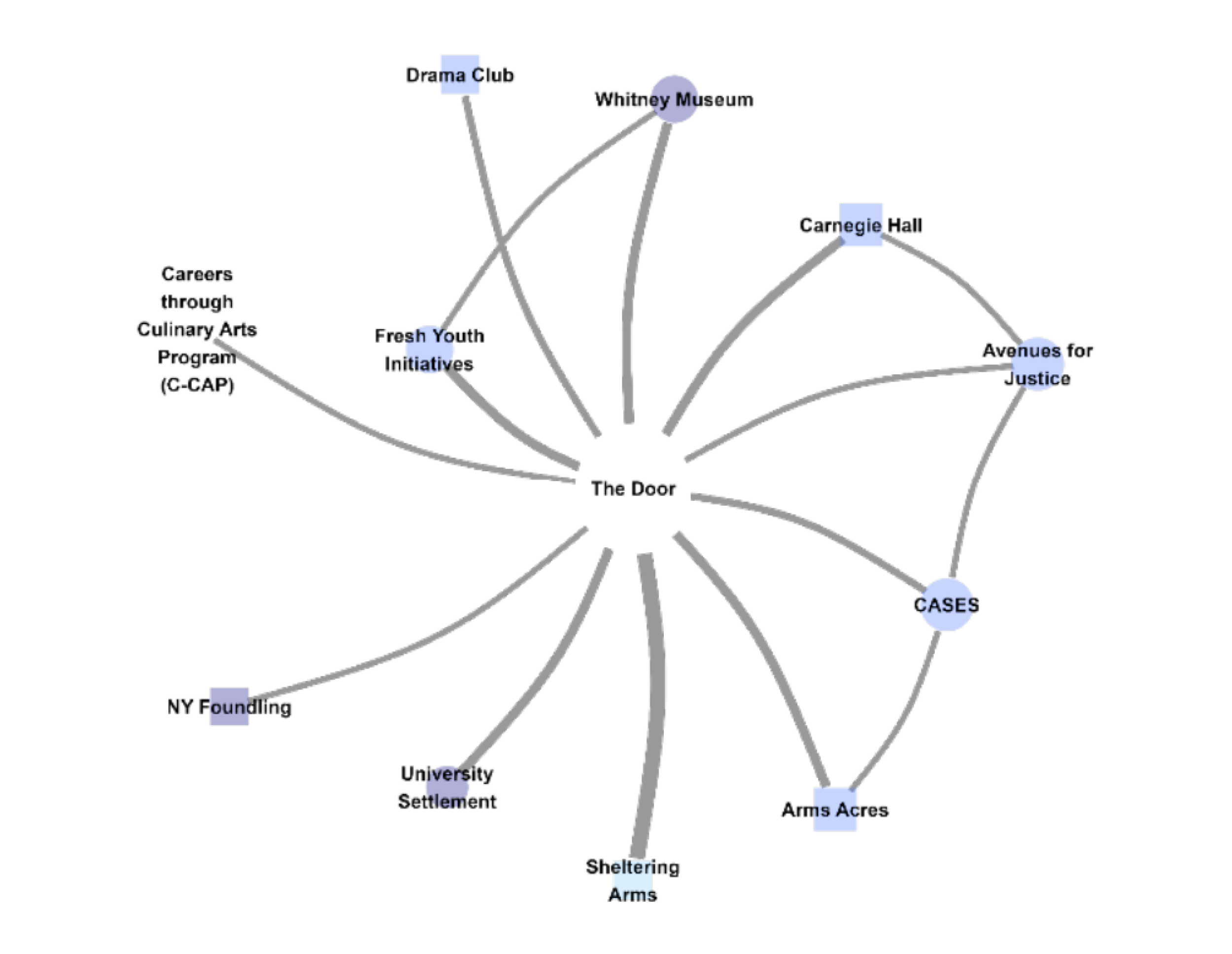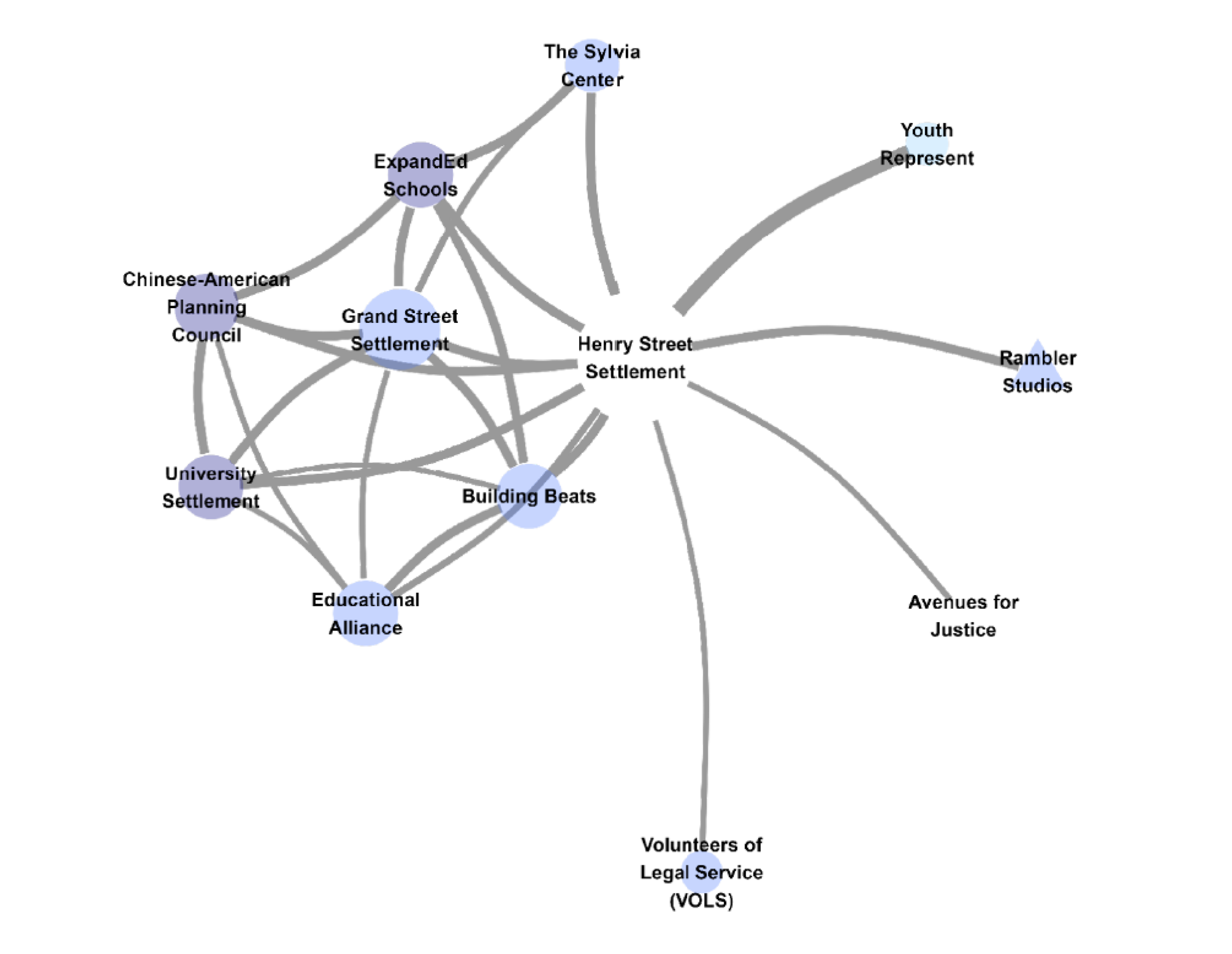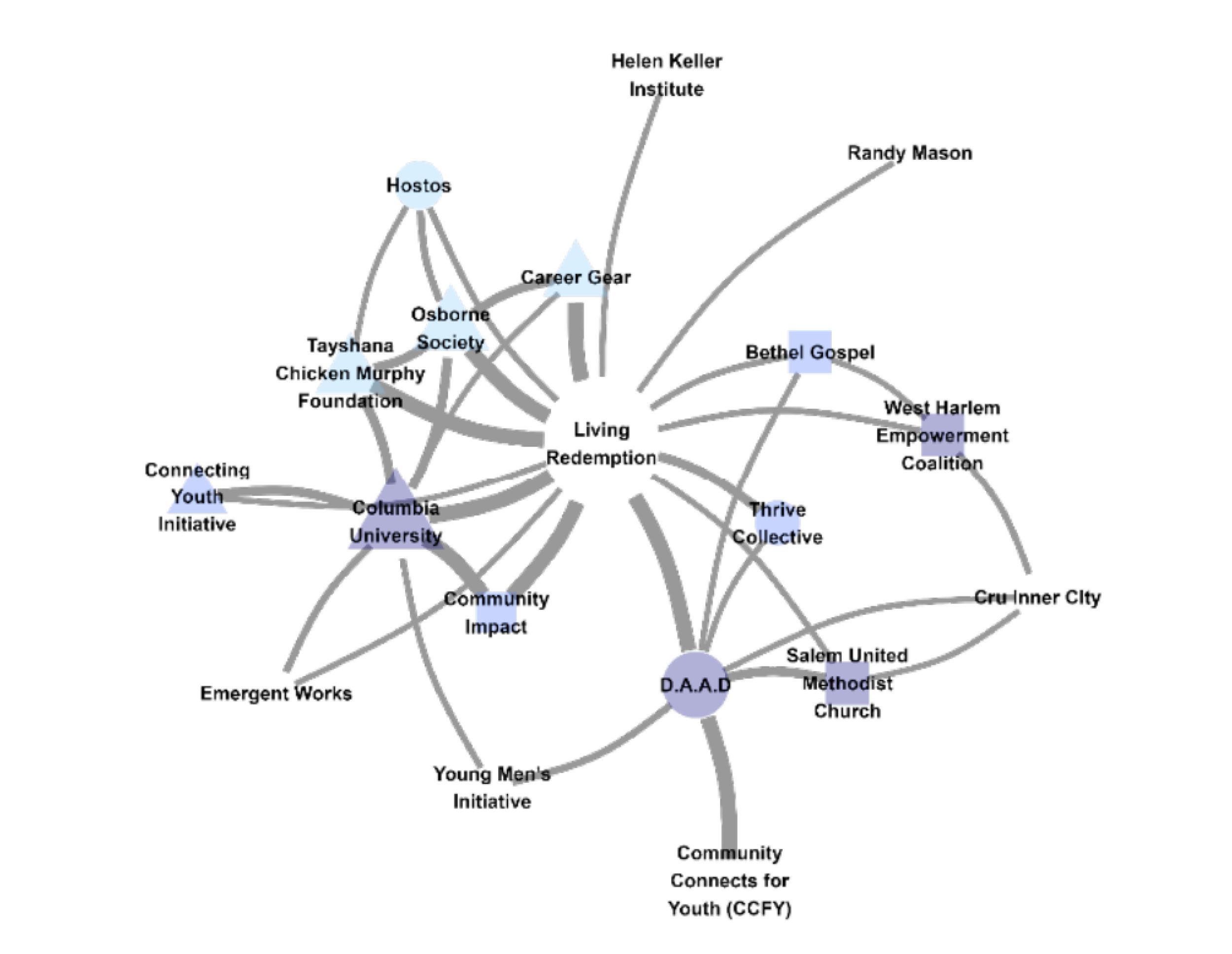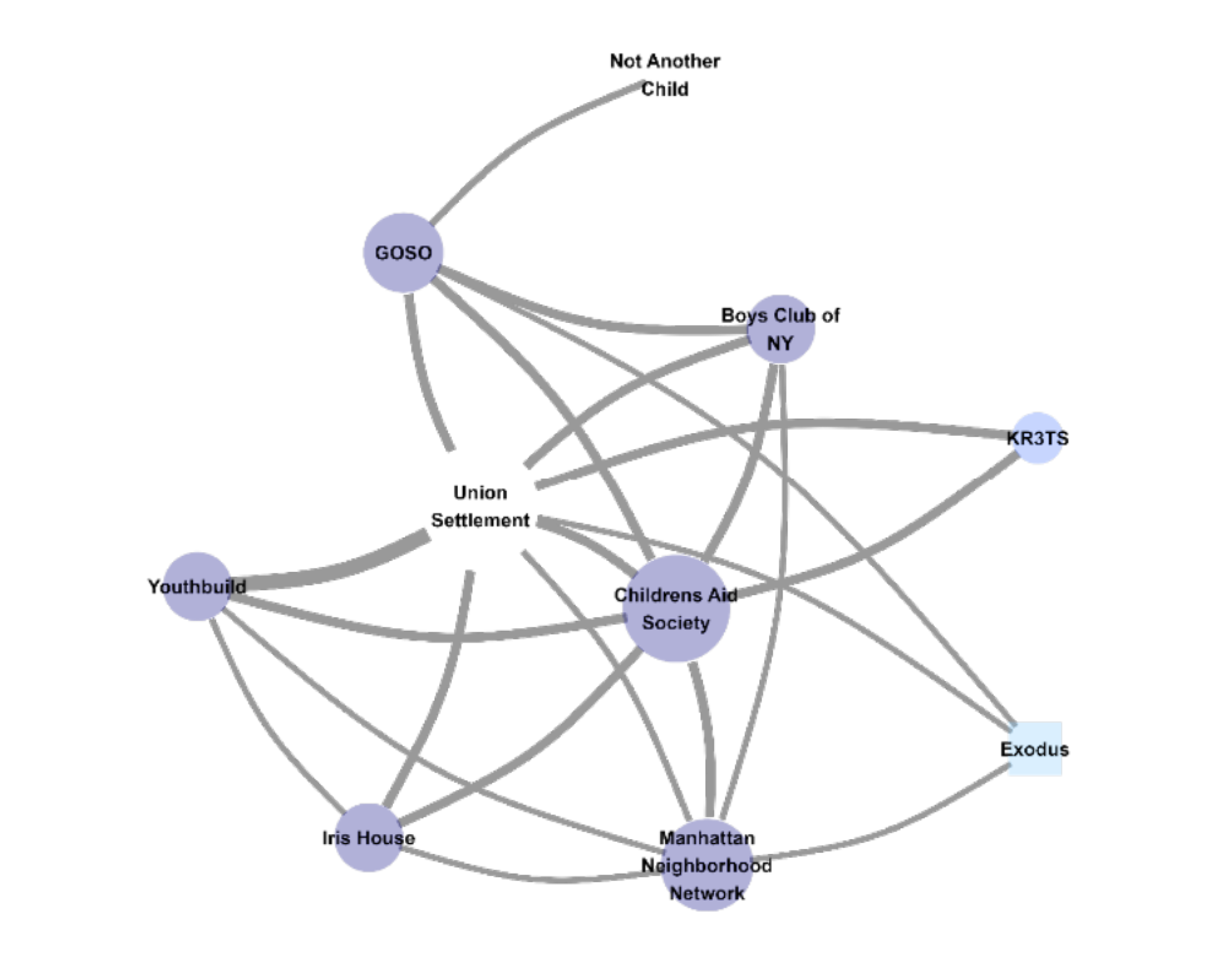Tapping into Strong Partnerships to Improve Youth Services: The Youth Opportunity Hub Initiative
By Brandon Martinez, Research Associate
Creating lasting organizational partnerships is essential for improving youth services in the city. Five New York City organizations invested time and money into developing Youth Opportunity Hubs, a unique network that helped them be more flexible, adaptive, and efficient. Even though initiative funding has ended, partners continue to work together to provide the best services to their participants.
The Youth Opportunity Hubs (YOH) initiative was funded by the Manhattan District Attorney’s Criminal Justice Investment Initiative (CJII) to improve safety in four neighborhoods — East Harlem, Central and West Harlem, Washington Heights, and The Lower East Side — that have experienced disproportionate impacts of divestment and criminal-legal system involvement. By providing flexible funding to five youth service organizations in Manhattan and their networks of partners, CJII was able to foster greater organizational collaboration that connected youth with a wide range of services across potentially disparate systems, including education, employment, prosocial, health, criminal justice, and family services.
Recent findings from an evaluation of the YOH initiative, conducted by Westat and Metis, found that the Hubs were successful in creating unique partnership networks that built on their organizational strengths and the needs of their youth participants. The networks they created helped the Hubs be flexible and adaptable in providing youth services, efficient and resilient against partner changes, and prepared to share resources across many partner organizations. Although most CJII funding for the YOH initiative ended in 2022, the networks continue to thrive and most Hubs continue to operate, thanks in part to the lasting impact of flexible funding and dedicated investment in developing partnerships between community-based organizations.
Developing Hub Models with Lead Organizations and their Partners
When ISLG began initial research and outreach for CJII, one theme we heard frequently from community partners was that organizational silos (e.g., organizations not communicating with each other, competition prioritized over collaboration, and different sectors not sharing their knowledge) were a major barrier to youth effectively receiving services. Young people could easily fall through the cracks and not receive effective service referrals (or have those referrals implemented). In response, the YOH initiative was designed and funded to address organizational silos, strengthen collaboration, and improve youth service provision. Each of the five lead Hub organizations developed a unique model that built on its strengths and the needs of the youth in their community.
Henry Street Settlement is a 100+ year-old settlement house in the Lower East Side. Henry Street used a deployment model to create multiple entry points to services through the use of out-stationed social workers at partner settlement houses and subcontracted partners for additional services.
Union Settlement is an East Harlem-based settlement house with a 100+ year history. Union used a “warm handoff” approach to link youth to community service providers and worked with partners to provide on-site services and referrals.
The Door is a multi-service youth center with locations throughout Manhattan that provide career, education, criminal legal, and more youth services. The Door expanded its wraparound service offerings by collaborating with co-located partners on site and subcontracting partners for additional services.
Living Redemption is a young grassroots organization with a restorative approach. The Hub engages with youth through Credible Messengers and collaborates with many partners to connect youth to needed services.
New York-Presbyterian (NYP) is a major medical center that created a drop-in youth center staffed by licensed professionals. NYP worked with a small group of primary partners to increase access to services and developed education and career opportunities for participants.
Despite differences across Hub models, all five Hubs were successful in delivering holistic youth services and building on organizational strengths. The Hubs did so by working with partners to provide youth with a host of wraparound supports (Figure 1), including prosocial, educational, employment, and health services.[1] In addition to direct services, Hub partners worked with each other to provide staff time, strategic communications, and meeting space (Figure 2). More information on the impact of the Hubs model on youth outcomes can be found here.
figure 1. Direct services provided by partners
Source: Provider Network Survey, June - September 2021
figure 2.resources provided by partners
Source: Provider Network Survey, June - September 2021
Understanding Organizational Networks
Hubs were able to share resources because of the robust network of partners they developed throughout the course of the initiative. Each network diagram below shows how partners collaborated with each other and the main Hub organization (Figure 3). Each Hub’s network reflects a unique approach to breaking down organizational silos by building on organizations strengths and developing partner organizations.
Henry Street Settlement’s network was characterized by a dense cluster of interconnected partners that collaborated with each other and included four additional settlement houses as primary partners and hosts for Hub staff, and a small set of secondary partners for specific services.
Union Settlement built a large network made up of subcontracted community organizations that collaborated with each other to provide onsite services and referrals.
The Door’s centralized network created strong ties between itself and its co-located partners, and reflects the enhancement of its existing and robust wraparound service provision.
Living Redemption developed a dense network of partners with long-standing contracts that formed several collaboration clusters with younger and grassroots organizations.
New York-Presbyterian’s network included a small group of partners that collaborated with each other, provided services outside of NYP, and could receive and send referrals.
figure 3. hub network diagrams





Each of these network organizational models had implications on how individual Hubs coordinated:
Flexibility and Adaptability
Networks with many highly connected partner organizations that form many sall sub-groups of partners are more flexible and adaptable to change because they are made up of more connections and do not need to rely on fewer partners to collaborate. Henry Street Settlement’s network had many clusters and, in turn, was less hierarchical. In practice, Henry Street’s partners were highly collaborative and youth would often receive warm handoffs between services. Henry Street fostered collaboration through regular partnership meetings and youth events that brought partners together in one room to support participants.
Efficiency and Resilience
Highly connected networks can also increase a Hub’s efficiency and resilience against severed partner relationships. Living Redemption’s network, for instance, featured many connections between partners. As such, multiple entry points to the Hub network increased its ability to provide services to youth regardless of how they became connected to the Hub. By contrast, The Door developed strong relationships with its collocated primary partners that provided on-site services, as reflected in its centralized network model. Both these hubs provided critical services to young people, and they showcase how different partnership models (more versus less centralized) can be effective in different service environments.
Sustaining the Partnership Model
CJII funding for the YOH initiative has officially ended, but that hasn’t stopped the Hub networks from continuing to provide services to youth. Although the degree of partnership has decreased with the end of funding, the strong organizational relationships developed during the initiative have continued to support resource sharing and collaboration across the networks (Figure 4). For example, one-quarter of all Hub partners continue to provide direct services to Hub youth and referrals to external services. Many partners also provide organizational support to the Hub in the form of staff time (16%) and meeting spaces (18%).
figure 4. change in resources provided by partners
Source: Provider Network Survey
ABOUT THE PROGRAM AND EVALUATION
The Youth Opportunity Hubs helped youth meet their basic needs, provided wraparound youth services, supported young people’s positive development and provided them with supportive relationships, and provided them with a greater sense of belonging and hope in their lives and communities. As a result, the YOH initiative has helped provide alternatives to the criminal legal system and made communities safer.
The final evaluation report, including process, outcome, and cost-study findings, as well as a policy brief on evaluation findings, is available here. An earlier mid-evaluation report describing process evaluation findings in greater depth is available here.
ABOUT THE CRIMINAL JUSTICE INVESTMENT INITIATIVE
The Manhattan District Attorney’s Criminal Justice Investment Initiative (CJII) focuses on three investment areas—crime prevention, reentry and diversion, and supports for survivors of crime. The Youth Opportunity Hubs are part of the CJII’s crime prevention-focused investments in Youth, Families, and Communities.
The CUNY Institute for State and Local Governance manages and provides technical assistance to CJII contractors, and conducts oversight and performance measurement throughout the lifetime of the initiative.
[1] Services included prosocial (leadership opportunities and mentorship with youth and staff), educational (college planning, test preparation, and goal setting), employment (job training and in-Hub employment), and health (social and emotional care provision within Hub).




